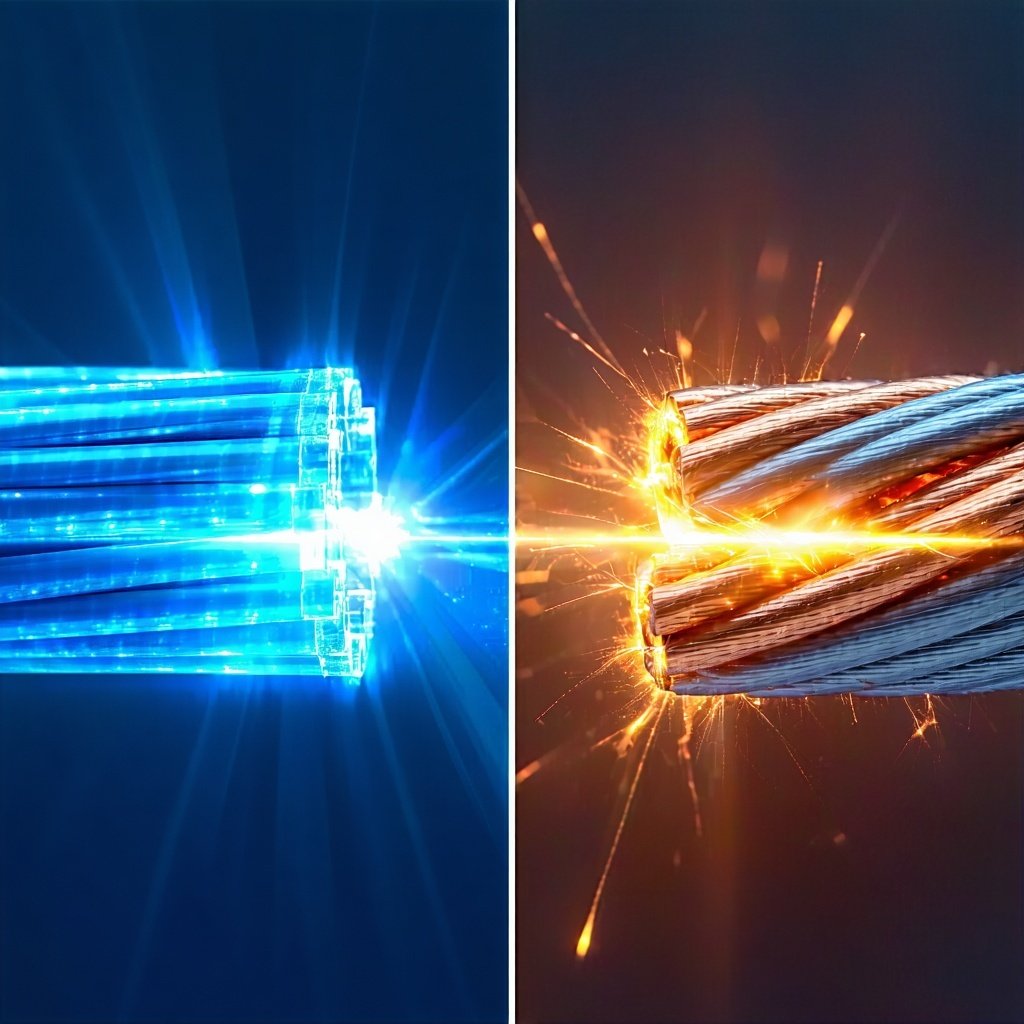Fiber Optic Cable vs Copper Cable: Which One Will Power the Future of Your Network?
Choosing the right foundation for your network infrastructure is a pivotal decision. At the heart of this choice lie two primary contenders: fiber...
6 min read
 Tony Ridzyowski
:
Jul 28, 2025 11:43:34 AM
Tony Ridzyowski
:
Jul 28, 2025 11:43:34 AM
Behind every reliable network is a structured cabling system that quietly does the heavy lifting. While wireless access and cloud platforms get most of the attention, none of it works without properly installed network cables connecting switches, servers, and devices. When structured cabling is well-planned and correctly installed, it reduces clutter, improves uptime, and gives IT teams a system that’s easy to expand and even easier to maintain.
A solid structured cabling installation follows industry standards, uses the right types of cables for each part of the network, and supports both current bandwidth demands and future capacity. According to BICSI, 30% of network downtime is caused by cabling-related issues, underscoring how critical a well-designed system is to overall performance
TL;DR:
Structured cabling is the physical backbone of every modern IT environment. This guide explains how to plan and install a structured cabling system that meets performance requirements, aligns with cabling standards, and supports long-term growth. Learn how TTI Cable helps build networks that are clean, scalable, and easy to manage, starting with the right infrastructure.
A structured cabling system is a standardized method of installing and managing network cables in a way that supports high performance, scalability, and clean organization. Unlike traditional point-to-point cabling, where devices are connected directly in an ad hoc manner, structured cabling follows a planned layout that uses subsystems, cable management standards, and defined termination points. This approach reduces cable clutter, simplifies maintenance, and supports long-term growth.
Instead of running separate cables for each device, a structured cabling infrastructure groups cabling into organized bundles that run through telecommunications rooms, patch panels, and horizontal or backbone routes. This makes it easier to expand networks, upgrade hardware, and troubleshoot issues quickly. The design supports various systems like voice, data, security, and building management without needing separate wiring for each.
Structured cabling systems are installed anywhere a stable, organized, and scalable network is needed. These environments often support high volumes of data, require long-term flexibility, and must comply with cabling standards.
A structured cabling system is made up of several key subsystems, each with a defined function in supporting the overall network. These components work together to deliver a cabling infrastructure that is organized, standards-compliant, and ready for future expansion.
Horizontal cabling connects workstations to telecommunications closets, typically on the same floor. These runs use Ethernet cables like Cat6 or Cat6A and support day-to-day device connections. Vertical cabling, or backbone cabling, links telecom rooms, equipment rooms, and floors together. These runs often rely on fiber optic cables to move high volumes of data between network segments. Both are essential—horizontal for endpoint access, vertical for inter-floor or inter-building links.
Patch panels organize cable terminations and allow for quick reconfiguration without disturbing the main cable runs. They connect to Ethernet cables, typically Cat6, Cat6A, Cat8, or fiber, depending on bandwidth and distance requirements. Wall outlets serve as the user connection point, linking endpoints like computers or VoIP phones to the structured cabling system.
Telecommunications closets handle cable terminations and switching on each floor, while equipment rooms support core network hardware and backbone cabling. These spaces must be planned for ventilation, cable management, and physical security. A clean layout helps technicians manage the cabling network efficiently and reduces the chance of downtime during changes or repairs.
Structured cabling systems follow defined industry standards to ensure consistent performance, safety, and compatibility. These guidelines shape how systems are designed, installed, and maintained across different building types and environments.
The ANSI/TIA-568 standard governs structured cabling design and installation across commercial environments. It details approved cable types, length limits, termination methods, and labeling requirements. It also defines the layout for backbone and horizontal cabling, patch panel setup, and how each subsystem should connect. Following this standard ensures the cabling infrastructure supports current data speeds and remains compatible with future upgrades.
Cable jackets must match the fire safety requirements of their installation environment. Plenum-rated cables meet strict standards for flame resistance and low smoke and are required in air-handling spaces like ceiling voids and ventilation ducts. Riser-rated cables are used in vertical shafts between floors where air circulation is limited. Selecting the correct rating ensures the installation meets local fire codes and passes inspection.
A strong structured cabling system starts with planning and ends with precise execution. Rushing into installation without clear network goals or layout decisions often leads to disorganized pathways, costly rework, and limited future flexibility. This section outlines how to plan, design, and carry out a structured cabling installation that supports long-term performance and scalability.
Define what the network will support—data, voice, video, wireless—and choose cable types that meet those demands. Cat6 handles most gigabit needs, while Cat6A or Cat8 supports higher speeds or longer runs. Fiber optic cables are often used for backbone cabling where bandwidth and distance are critical. Matching cable specs to performance goals prevents rework later.
Group devices into logical zones and map cable routes before installation. Planning paths through trays, conduits, and risers reduces clutter and physical strain on cables. Maintain separation between data and electrical wiring to avoid interference. Organized routing improves airflow, shortens cable runs, and makes the system easier to manage.
Work with an installer who is certified, experienced, and follows TIA/EIA standards. They should understand code requirements, plenum and riser use, and deliver fully labeled, tested cable runs. A proper installation reduces downtime, simplifies future changes, and ensures the system meets performance targets from day one.
Installations start with a site walkthrough and blueprint review to identify pathways, connection points, and hardware locations. During the build, cables are routed cleanly, labeled on both ends, and terminated to patch panels or outlets. Final testing confirms performance and compliance, and documentation maps every connection for future reference.
Structured cabling provides a stable foundation for any network. It supports clean layouts, reduces maintenance time, and ensures consistent connectivity across devices and systems. A properly designed cabling system is easier to manage, faster to scale, and built to meet performance demands over time.
Labeled patch panels, clear cable routes, and organized pathways make it easier for technicians to trace issues and perform updates. When cables are structured properly, faults can be isolated without guessing, and moves or changes don’t require tearing apart racks or ceilings. A clean system reduces downtime and shortens service windows.
Structured cabling is designed with future growth in mind. Standardized layouts and scalable pathways allow for adding new devices or replacing hardware without pulling out existing cables. Using widely adopted cabling standards, like TIA/EIA and ANSI, ensures compatibility with future technologies and minimizes the cost of expansion.
A well-installed cabling system delivers stable, uninterrupted performance. Proper shielding, cable separation, and termination prevent signal interference and packet loss. High-quality materials paired with clean installation support higher data rates, stronger throughput, and fewer performance issues across the entire network.
Structured cabling systems must support both current workloads and future expansion. Long-term reliability depends on using high-quality components, keeping accurate records, and sourcing materials from a manufacturer with proven experience in structured infrastructure.
Cabling systems perform best when built with precision materials. Copper grade, shielding type, and connector quality all influence speed, stability, and resistance to interference. Following structured cabling standards like TIA/EIA ensures the system supports both current performance and future upgrades. Using tested, standards-compliant materials also reduces the risk of rework or failure after installation.
Maintaining diagrams, labels, and test records is essential. Clear documentation helps teams trace connections, plan expansions, and respond quickly during service calls. When layouts are mapped and cables are labeled, troubleshooting is faster, and downtime stays low. Updated records also keep the system compliant with internal IT policies and audit requirements.
Working with the right structured cabling manufacturer can impact the long-term reliability of your entire network. TTI Cable delivers made-to-order, standards-compliant cable systems that meet the performance demands of enterprise, education, industrial, and government environments. Every cable is tested for spec compliance and built to handle real-world installation conditions.
TTI Cable also supports clients beyond the product itself, with expert guidance from a team that understands both technical requirements and field challenges. If you’re planning a new structured cabling installation or upgrading an existing system, schedule a call with TTI Cable to get expert support from planning to delivery.

Choosing the right foundation for your network infrastructure is a pivotal decision. At the heart of this choice lie two primary contenders: fiber...

In modern business, a powerful and dependable network forms the backbone of daily operations and success. As information demands multiply, many...

1 min read
How do you extend your network without tearing it apart? Let’s say your team is upgrading a campus network, and the new building across the street...